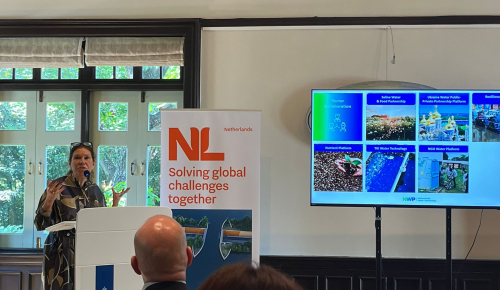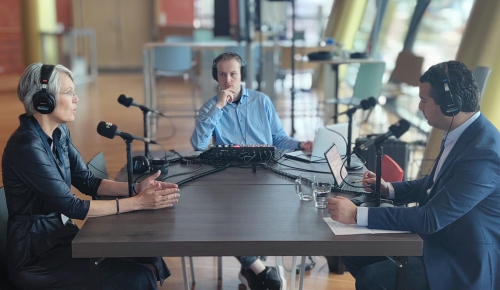
As we transition to a more sustainable world, removing silos and developing integrated solutions while balancing the need, use and management of resources is key. The water-energy nexus approach aims to do this. This nexus is the relationship between the amount of water used for energy generation and transmission, and the amount of energy required for water collection, treatment, transportation, storage, and disposal.
The Dutch Energy from Water Association (EWA), an NWP member, is a sector organisation that represents Dutch organisations that develop innovative solutions to generate energy from water. In this article, EWA talks about Dutch efforts in the water-related energy sector.
The role of energy from water in the energy transition
As part of its Energy Agenda, the Dutch Government’s goal is to reduce the Netherlands’ greenhouse gas emissions to zero by 2050. In the transition to sustainable energy, the Government recognises the importance of the business community, and supporting innovative sustainable energy technologies with grants, tax credit schemes and investment allowances.
While the transition to sustainable energy is on the Dutch Government’s agenda, energy from water is not yet viewed as a key form of sustainable energy. Peter Scheijgrond, chairman of EWA, believes that energy from water can be a key source of reliable, renewable energy to complement wind and solar. He lists several unique advantages and applications of energy from water in the energy transition.
“To begin with, energy from water can be used to power autonomous applications at sea such as aquaculture and offshore data buoys, and to charge unmanned vessels at sea. Even the oil and gas sectors are interested in reducing emissions from their offshore operations using energy from water solutions. A next step would be to integrate climate adaptation infrastructure solutions such as wave energy in exposed ports’ breakwaters and tidal energy in discharge and storm surge barriers.”
“The holy grail,” Scheijgrond believes, is the complete integration of energy from water solutions in offshore wind parks. “As a complementary source of energy, it can accelerate the energy transition, improve energy stability, and reduce the total system cost. In addition, it would also help create sustainable energy related jobs to replace fossil fuel related jobs. Energy from water is less volatile and therefore needs less energy storage. Moreover, the complete integration of offshore energy farms and energy from water solutions will generate more energy at a lower cost and use the sea space more efficiently.”
With the global increase in energy prices and dependence not only on imported fuels but also on imported technologies such as solar panels and batteries, there is an increasing desire for self-reliance in the current geopolitical climate.
Energy from water projects and prospects
EWA has several large and small members that have built pilot projects in the Netherlands and abroad. Water2Energy, developed as part of the INTERREG ENCORE project , is one of these pilot projects.
Reinier Rijke of Water2Energy, designed an innovative water turbine with a rotor that fits neatly in a tidal channel in the Port of Flushing in Zeeland. It is unique in integrating a climate mitigation solution (generating clean energy) and climate adaptation (protection against storms and sea-level rise). The rotor has a vertical axis, ensuring that the generator is accessible for inspection and maintenance above the water level. The square shaped rotor maximises the coverage and thus the energy captured from the flow through the channel. As the turbine rotates, each blade pitches to adopt the ideal angle to the tidal flow for optimal power capture.

EWA and its members have their sights set not just on the Netherlands, but also abroad. Its technologies could be used in Small Island Developing States and coastal regions all over the world. Increasing sea-level rise and storms all over the world are affecting vulnerable deltas and there is a growing need for integrated solutions that address both climate mitigation and adaptation. Delta cities such as Bangladesh, Shanghai, Jakarta and Bangkok are looking at protecting themselves from rising water. This may lead to business opportunities for Dutch companies working in the energy from water sector.
Tourist developments in the Caribbean and Pacific could also lead to opportunities for the water-related energy sector. Hotel complexes could use deep cold seawater to cool their rooms and even produce electricity as a by-product, thereby saving on electricity and reducing their dependence on imported fuels. Additionally, island nations in Asia and South America with high tidal currents or good wave conditions can benefit from wave and tidal solutions to power their economies with a reliable energy supply.
EWA is working to increase the visibility of Dutch innovative solutions abroad, particularly in terms of sustainable deltas, but is taking a different perspective – the energy lens. To EWA, becoming an NWP member means taking a reliable highway towards its main goal.

Meet EWA at the NWP Member Tour
EWA will be part the NWP Member Tour programme that will take place from 16 to 23 May 2022. If your organisation is also an NWP member, join us on this tour and learn more about EWA, its members, and its members’ projects. You can also contact Peter Scheijgrond or Menno Broers at contact@energieuitwater.nl for more information on water-related energy.
Featured NWP members: Dutch Energy from Water Association






